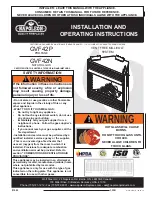
17
■
The following explains a typical procedure to be followed
in checking gas pressures.
■
The gas pressures will vary depending upon fuel type.
■
Consult the dataplate on the heater or page 4 in this
manual for specific pressures to be used in conjunction
with this procedure.
■
Gas pressure measured at the gas control valve will verify
proper inlet and burner manifold pressures.
A. Preparation
1.
Obtain a pressure gauge capable of reading up to 35
in. W.C.
2.
Disconnect the heater from the electrical supply and
close the fuel supply valve to the heater inlet.
3.
Remove the bottom base panel.
4.
Brush or blow off any dust and dirt on or in the vicinity
of the gas control valve.
B. Gauge Installation
1.
Remove the pressure tap plug on gas control valve. See
Fig. 22.
FIG. 22
2.
Install the gauge at the gas control. See Fig. 23
FIG. 23
3.
Po s i t i o n t h e h e a te r u p r i g h t . L owe r t h e h e i g h t
adjustment leg to elevate the heater and prevent
pinching of gauge hose See Fig. 24.
FIG. 24
C. Reading Pressures
1.
With the heater operating, the pressure gauge must
read the pressures specified on the dataplate
2.
Does the reading at the gas control valve agree with
that specified on the dataplate? If so, then no further
checking or adjustment is required. Proceed to section
D.
3.
If the inlet pressures do not agree with that specified
on the dataplate, then the regulator controlling gas
pressure to the heater requires adjustment.
D. Completion
1.
Once the proper pressure has been confirmed and/or
properly set, close the fuel supply to the heater and
allow the heater to burn off any gas remaining in the
gas supply line.
2.
Disconnect the heater from its electrical supply.
3.
Remove the gauge.
4.
Install pressure tap plug and tighten securely
5.
Open the fuel supply and start the heater. Check for
gas leaks at the plug Set heater’s thermostat to
desired temperature.
GAS PRESSURE CHECKS
PLUG
GAUGE CONNECTED
TO GAS CONTROL
















































